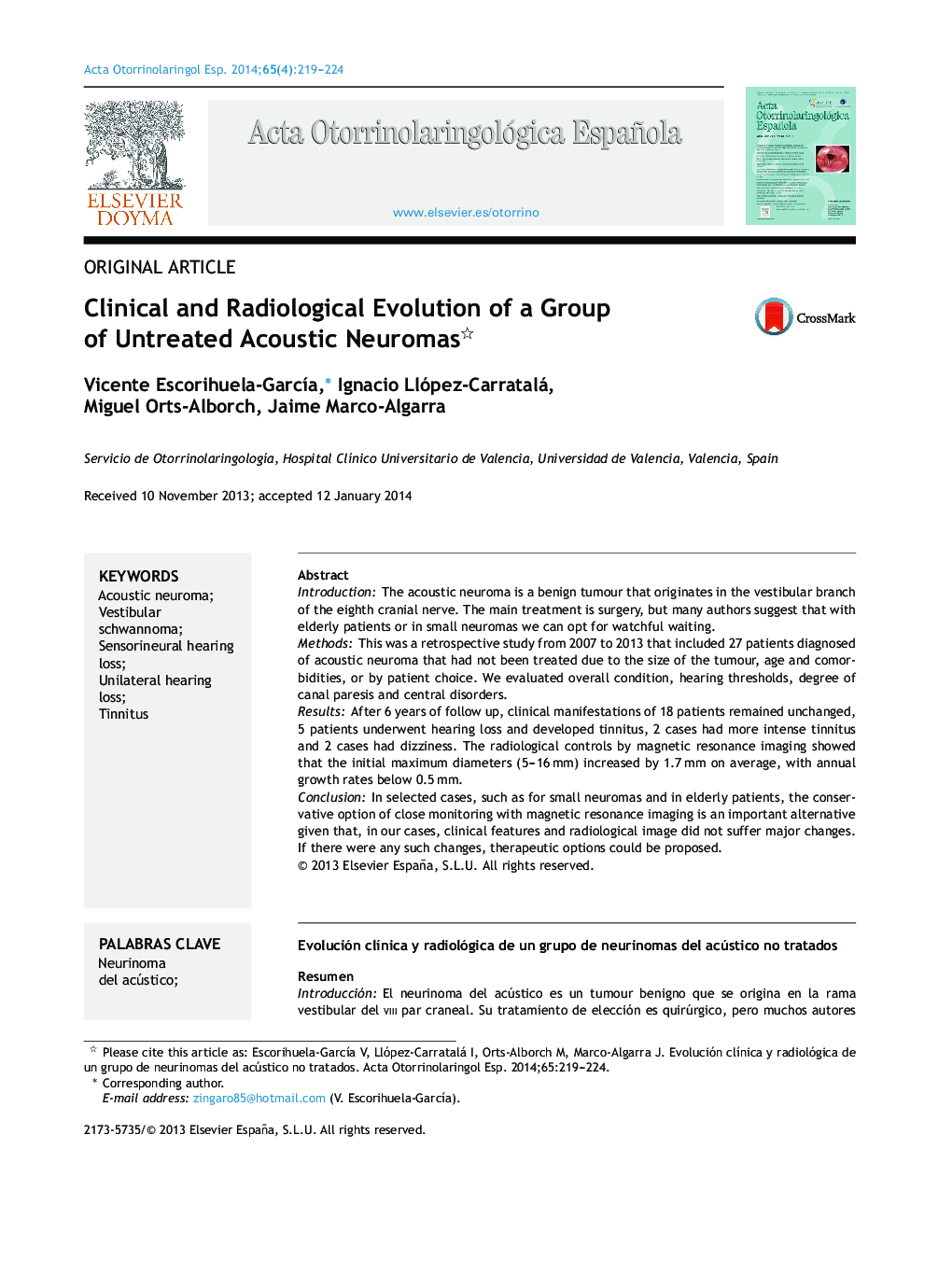| کد مقاله | کد نشریه | سال انتشار | مقاله انگلیسی | نسخه تمام متن |
|---|---|---|---|---|
| 4100769 | 1268727 | 2014 | 6 صفحه PDF | دانلود رایگان |

IntroductionThe acoustic neuroma is a benign tumour that originates in the vestibular branch of the eighth cranial nerve. The main treatment is surgery, but many authors suggest that with elderly patients or in small neuromas we can opt for watchful waiting.MethodsThis was a retrospective study from 2007 to 2013 that included 27 patients diagnosed of acoustic neuroma that had not been treated due to the size of the tumour, age and comorbidities, or by patient choice. We evaluated overall condition, hearing thresholds, degree of canal paresis and central disorders.ResultsAfter 6 years of follow up, clinical manifestations of 18 patients remained unchanged, 5 patients underwent hearing loss and developed tinnitus, 2 cases had more intense tinnitus and 2 cases had dizziness. The radiological controls by magnetic resonance imaging showed that the initial maximum diameters (5–16 mm) increased by 1.7 mm on average, with annual growth rates below 0.5 mm.ConclusionIn selected cases, such as for small neuromas and in elderly patients, the conservative option of close monitoring with magnetic resonance imaging is an important alternative given that, in our cases, clinical features and radiological image did not suffer major changes. If there were any such changes, therapeutic options could be proposed.
ResumenIntroducciónEl neurinoma del acústico es un tumour benigno que se origina en la rama vestibular del viii par craneal. Su tratamiento de elección es quirúrgico, pero muchos autores defienden que en pacientes de edad avanzada o en neurinomas de pequeño tamaño se puede optar por simple vigilancia.MétodosEstudio retrospectivo, del 2007 al 2013, que incluye a 27 pacientes diagnosticados de neurinoma del acústico que no fueron tratados, bien por el tamaño del tumour, por la edad y las comorbilidades asociadas, o por decisión del paciente. Se evaluaron el estado general, los umbrales auditivos, el grado de paresia canalicular y las posibles alteraciones a nivel central.ResultadosA los 6 años de seguimiento, la clínica –hipoacusia (70%), acúfeno (15%) y vértigo (4%)– de 18 pacientes se mantuvo sin variaciones; 5 casos experimentaron caída del umbral auditivo y desarrollaron acúfeno, 2 casos intensificaron su acúfeno y 2 casos presentaron vértigo. Los controles radiológicos por resonancia magnética demostraron que los diámetros máximos iniciales (5–16 mm) se incrementaron en 1.7 mm como media, con tasas de crecimiento anual inferiores a 0,5 mm.ConclusiónEn casos seleccionados, neurinomas de pequeño tamaño y pacientes de edad avanzada, la opción conservadora mediante vigilancia estrecha con resonancia magnética es una alternativa importante, puesto que, según nuestra muestra, ni la clínica ni la imagen radiológica sufren cambios significativos y, en caso de que lo hagan, siempre estamos a tiempo de una actuación terapéutica.
Journal: Acta Otorrinolaringologica (English Edition) - Volume 65, Issue 4, July–August 2014, Pages 219–224